Are you interested in growing spicy peppers? Well, growing your own peppers at home or indoor gardens shouldn’t be a problem as everyone knows that the best way to grow the biggest and tastiest peppers is with hydroponics.
The hydroponic method replaced the age-old method of soil gardening with a water-nutrient solution. It provides an easier system to grow your favorite peppers in small confined spaces.
Growing hydroponic peppers will require some knowledge of what the method entails, and how to start your own hydroponic pepper crop.
The results will be astonishing and you’ll reap some delicious peppers.
- Related article: Easy to Grow Hydroponic Plants
To help you with growing your hydroponic pepper farm, let’s take a look at some of the important things you need to know!
Why Grow Hydroponic Peppers?
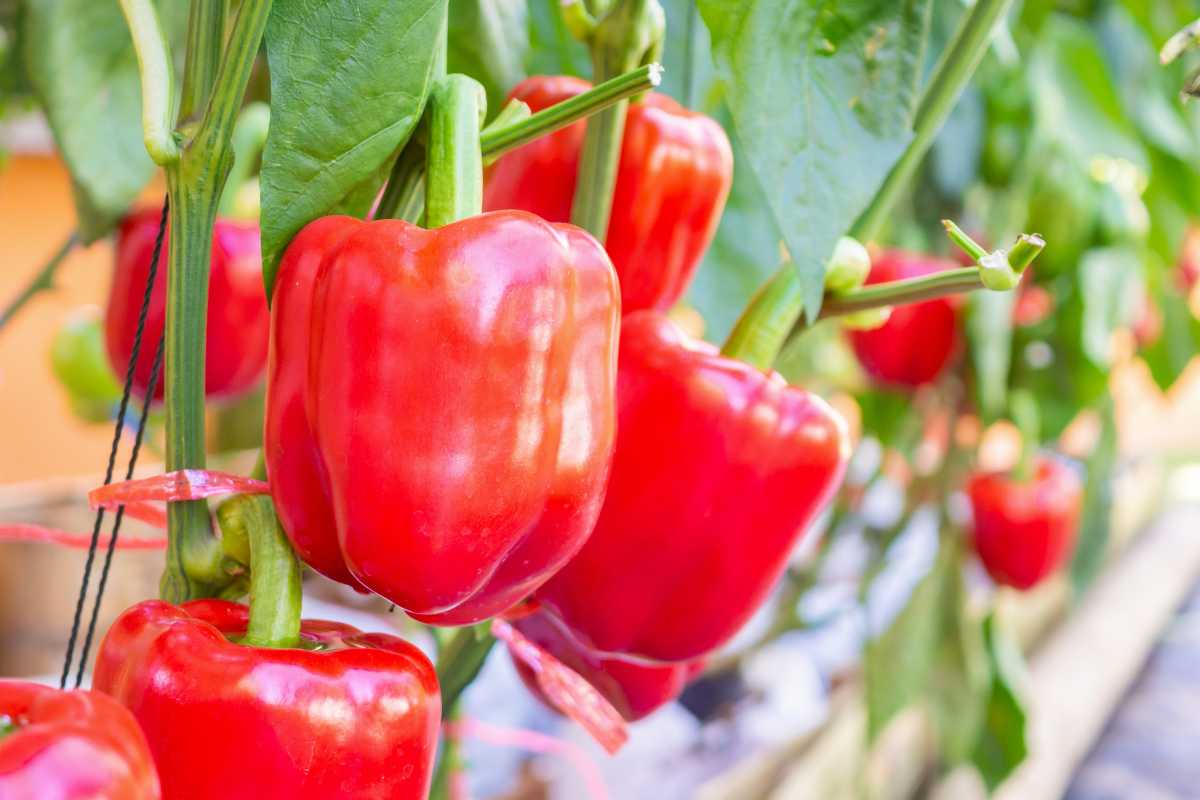
Benefits of Growing Hydroponic Peppers
- Hydroponics provides faster pepper growth than in soil.
- The indoor environment limits the number of pests that are able to infect your hydroponic farm.
- Hydroponically grown peppers taste better than average pepper plants that are soil-grown.
- Less risk of contracting soil-borne diseases.
- Hydroponics uses fewer nutrients, as your plants absorb all the nutrients in your water, and there is no runoff.
- Uses less water level than the traditional method of soil gardening.
- Stronger and healthier crops.
- You can grow all year round.
Drawbacks of Growing Hydroponic Peppers
- Requires constant maintenance on a daily basis.
- Water diseases are a problem with hydroponic farming.
- You will need to provide more artificial light than other growing methods require.
- Power outages can lead to your crops suffocating.
- The equipment needed to grow hydroponic peppers is expensive.
- Problems affect your plant more quickly. Hydroponics systems are more prone to faster malfunctions if something goes wrong.
Equipment Needed to Grow Hydroponic Peppers
Hydroponics setups have to use equipment to create an optimal environment for growing plants.
There are different hydroponic techniques that can be used to grow peppers and every technique uses its own preferred equipment.
However, the fundamental equipment types required will remain constant.
This list contains all the necessary equipment for growing peppers hydroponically:
- Air pump – A tool used to inject oxygen into a nutrient solution. This oxygen helps your peppers grow faster and healthier.
- Air stone – An air stone is a porous, ceramic stone that diffuses the oxygen produced by the air pump throughout the nutrient solution.
- Filter – A tool utilized in hydroponic planting to eliminate solid particles and other pollutants from water or air, usually by capturing them on or in a porous substance.
- LED or T5 grow light – A type of artificial lighting utilized for indoor plant cultivation. LED lights are a viable choice for hydroponic systems due to their energy efficiency and lower heat emission in comparison to alternative lighting options. Different options for light sizes, wattages, and color temperatures are available to cater to the specific requirements of plants.
- pH tester/EC meter – A device utilized for measuring the acidity or alkalinity of a solution. An EC meter is a tool used to quantify the electrical current present in a solution.
- Fan/Ventilation system – A system that is used in hydroponic planting to circulate air and maintain optimal temperature, CO2 levels, and humidity in the growing space.
- Irrigation – In the world of hydroponic planting, irrigation is the ultimate power couple—delivering vital water and nutrients to your beloved plants via a nutrient solution pumped directly to their roots.
- Water pump – An electrically-powered device that moves water from one place to another. It is important in hydroponic systems as it helps deliver nutrient-rich water to the roots of plants, which is essential for their growth.
- Net pots – Net pots are plastic containers that have multiple holes in them. The containers are intended for holding a substance that facilitates growth, such as Clay Pellets or Rockwool Cubes. Additionally, they facilitate pollen transfer and the transfer of plants to a hydroponic system.
- Pruning scissors – A gardening tool designed for the purpose of trimming plants through pruning. The sharp blades are utilized for pruning purposes, specifically to remove dead or diseased branches, leaves, and stems to encourage healthy growth.
- Dehumidifier – A tool utilized in hydroponic gardening to decrease humidity levels, which can aid in avoiding plant diseases. This device functions by extracting extra humidity from the air, aiding in the maintenance of healthy and flourishing plants.
- Water pipe – A hydroponic method of plant cultivation that eliminates the need for soil. The plant’s roots receive water, nutrients, and air through a solution that is rich in nutrients and based on water.
- Grow trays – A type of container utilized in hydroponic gardening to cultivate plants. Hydroponic containers are commonly filled with a nutrient solution and designed with holes or slots to accommodate the plant’s roots.
- Water reservoir – A receptacle designed to store water, often utilized in hydroponic gardening. The container is usually filled with water that contains essential minerals for plants to grow and thrive.
How to Grow Hydroponic Peppers
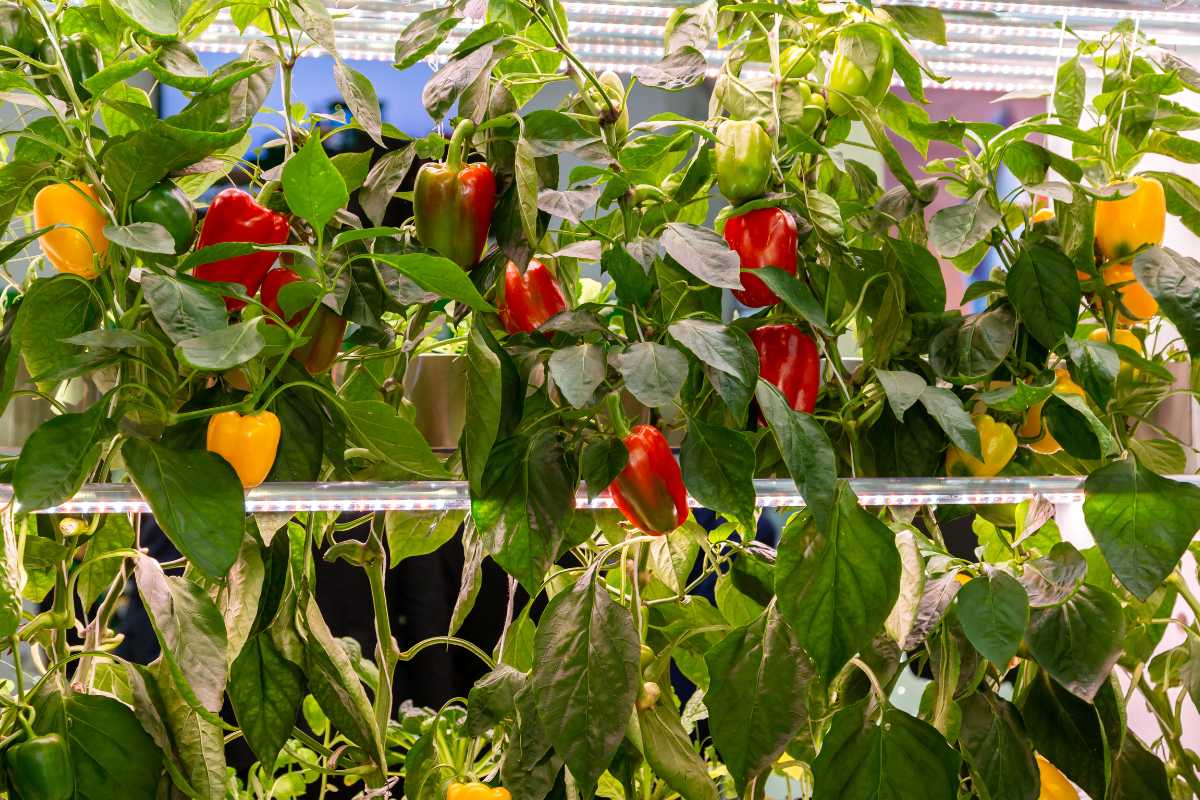
Choose the Right Pepper Variety to Grow
Hydroponic systems are a common method for cultivating peppers.
Hydroponics offers the opportunity to grow various types of peppers, including new ones that are produced each year.
These are some of the popular pepper varieties grown hydroponically:
- Black Pepper – A spice that is frequently utilized and is derived from the dried, unripe fruit of the Piper nigrum plant. The seasoning is commonly used on food and has a strong, tangy taste.
- Cayenne Pepper – A type of chili commonly used to add flavor and spice to dishes. This pepper in a particular hue of red is often utilized in a finely pulverized form, either as a powder or as a paste. Cayenne peppers are a widely used ingredient in different culinary traditions such as Mexican, Thai, Chinese, and Indian cuisine.
- Anaheim Pepper – A beloved addition to Mexican cuisine that packs a flavorful punch ranging from mild to medium-hot. It is typically long and tapered, with a bright green color that turns red when mature. Anaheim peppers are a staple in mouthwatering dishes like chiles rellenos and enchiladas.
- Habanero Pepper – A type of chili pepper that is known for its intense spiciness and fruity flavor. It is typically colored red or orange and has a Scoville Heat Unit range of 100,000 to 350,000.
- Brown Pepper – A variety of chili pepper that is recognized for their mildly sweet flavor. They have a strong aroma and a deep brown color when mature. Brown peppers can be used in cooking or eaten raw.
- Cubanelle Pepper – Cubanelle peppers are a popular variety of sweet pepper, originating in Cuba. The peppers are large in size, moderately spicy, and possess a subtle fruity flavor. These peppers are typically 4-8 inches long and are commonly harvested when they reach a pale green color.
- Bell Peppers (Yellow, Red, or Green Peppers) – A variety of sweet pepper belonging to the Capsicum family. These peppers come in a variety of colors, including red, yellow, green, orange, and purple.
- Blue Pepper – A chili pepper that turns dark blue-purple when mature and has a spicy, earthy flavor. It is a popular ingredient in cooking due to its ability to enhance visual presentation and add a subtle level of spiciness.
- White Pepper – A variety of pepper obtained from fully ripened peppercorns that undergo a process of soaking in water and subsequent drying.
- Tabasco Pepper – A type of chili pepper that come in red or green, originating from the Mexican states of Tabasco and Veracruz. They are highly spicy, with a heat rating ranging from 30,000-50,000 Scoville Heat Units (SHUs), and are commonly used in the production of hot sauces, including Tabasco sauce.
It should be noted that hydroponic systems have the ability to cultivate a diverse range of pepper plants, beyond those mentioned.
Choose the Hydroponic Technique
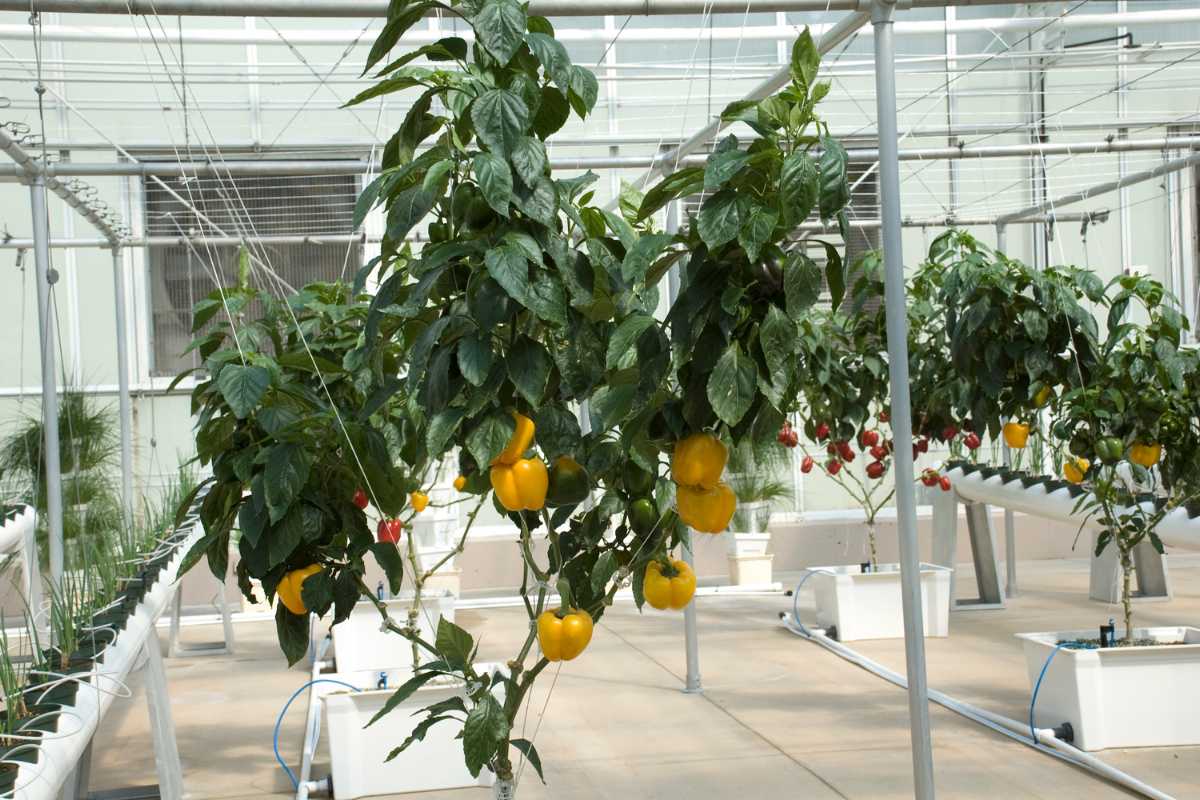
Various hydroponic techniques are utilized for cultivating different plant species.
The following is a list of hydroponic techniques commonly used in plant cultivation:
- Nutrient Film Technique (NFT) – A hydroponic system that utilizes a shallow stream of nutrient-rich water to continuously provide plants with necessary nutrients over a substrate.
- Ebb and Flow – A hydroponic gardening method that involves the use of a reservoir and timer to supply plants’ roots with nutrient-rich water.
- Drip System – A system that provides a consistent flow of water and nutrients to plant roots through slow and steady drips.
- Deep Water Culture (DWC) – A type of hydroponic system in which plant roots are suspended in water and oxygen is provided through an air pump.
- Aeroponics – A method of growing plants where they are suspended in an open space and their roots are misted with nutrient-rich water or liquid fertilizer solution.
- Wicking – A hydroponic method that involves the use of capillary action to draw water and nutrients from a reservoir.
- Kratky – A system that involves the cultivation of plants in a nutrient solution that does not circulate or move.
Among these methods, the Deep Water Culture (DWC) and Ebb and Flow technique are the most commonly utilized hydroponic methods for growing peppers.
Deep Water Culture
The easiest hydroponic technique to grow pepper in is the Deep Water Culture system. The DWC system suspends your pepper plant’s roots in a water reservoir.
The water reservoir is oxygenated by the use of an air pump or air stone and nutrients are added to your water.
It is important to ensure that your roots are covered from any potential light. Algae will begin to grow in your hydroponic system and on your plant’s roots if there is any light that penetrates through.
Pepper plants seem to grow well in this technique and it can be used on a large scale or simply in a container, so you won’t need acres of land to grow peppers.
Ebb and Flow
The Ebb and Flow technique, or otherwise called the “flood and drain” system, floods the roots of your plants with nutrient-rich water and then drains the water back into your water reservoir.
This flooding and draining technique is repeated continuously throughout the day. A timer and water pump are needed for this technique.
Light and Temperature Conditions
Hydroponic peppers require plenty of light. Outdoor growth of these plants necessitates nearly an entire day’s worth of exposure to natural light.
Indoor pepper growers, often using hydroponics, should provide their plants with 12 to 18 hours of artificial light.
The amount of light required by your plants will depend on the strength of your grow light.
The type of pepper plant grown in the system will impact the required amount of lighting.
For optimal growth, the recommended daytime temperature range is between 73℉ and 78℉, with a recommended evening temperature range of 65℉.
Transform your peppers into powerhouses by optimizing the temperature range in your grow room or greenhouse!
Water and pH Levels
It is recommended to use water with a pH level between 5.5 and 7.0 for optimal growth of hydroponic peppers. The required pH level may differ depending on the specific variety being grown. Generally, peppers thrive in slightly acidic water.
It is recommended to maintain the water temperature in a hydroponic system within the range of 65℉ to 80℉.
Growing Medium
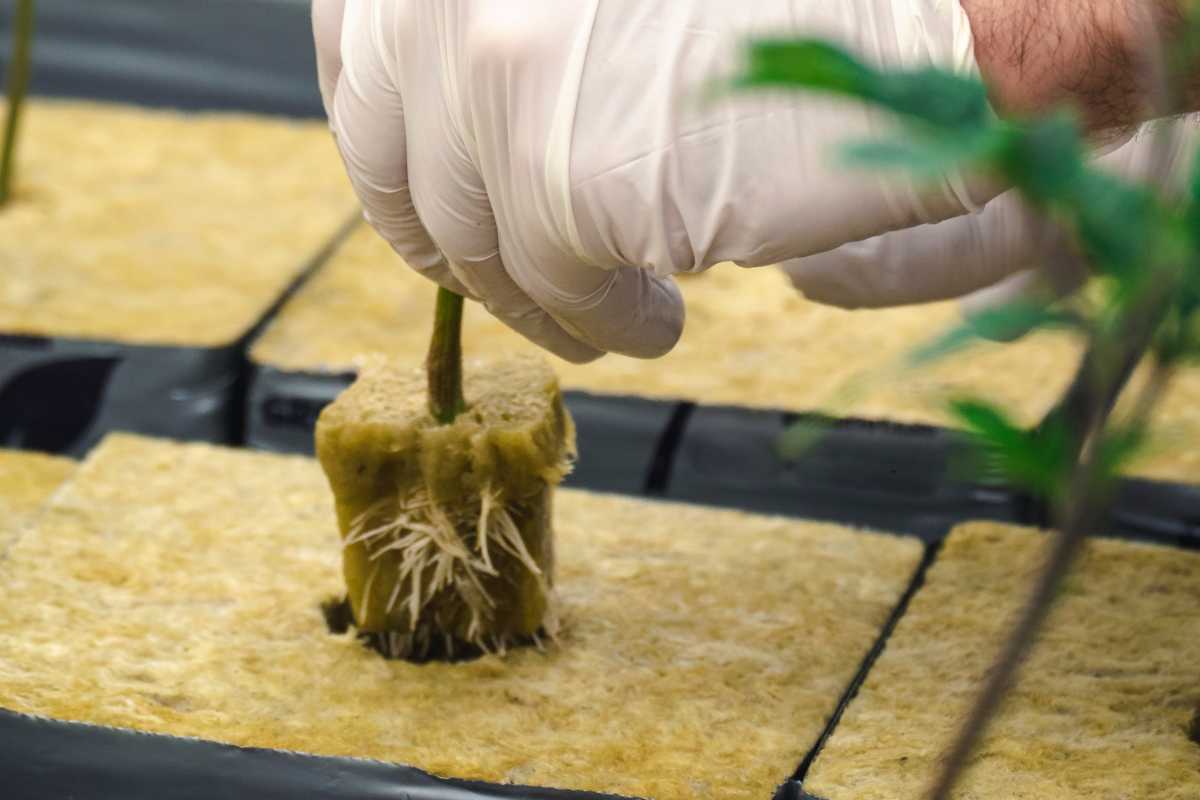
The best-growing medium for growing hydroponic peppers will be dependent on the hydroponic system that is used.
There are multiple growing mediums available for hydroponic systems.
However, the particular growing mediums that are recommended for growing peppers are:
- Rockwool or Stonewool – An insulation material made from molten rock that has been heated to 1600°C and spun into fibers. Rockwool is good for hydroponic plants because it retains water, allows air to circulate, is lightweight, and is eco-friendly as it does not harm the environment.
- Clay Pebbles – A kind of medium commonly used in hydroponic systems. The balls are formed by firing clay at high temperatures, resulting in a round and porous shape. The pebbles create an optimal environment for root growth by retaining moisture and nutrients while allowing for oxygen flow and drainage.
- Jiffy Plugs – Starter pots made from compressed peat moss that are small and lightweight. They provide an ideal environment for young plants to quickly establish roots, allowing them to be transplanted into their final hydroponic setup with ease.
It’s best to use Rockwool as a growing medium for pepper seeds that are in the germination stage.
If you are planting seedlings into your hydroponic system, you can always use Clay Pebbles as a growing medium.
Nutrient Solution
Unlock the secret to maximum growth in your hydroponic system—the key lies in expertly dosing nutrient solution and carefully adjusting nutrient levels with top-quality hydroponic nutrient packages.
Pepper plants require both macro and micronutrients for optimal growth, with the essential macronutrients being nitrogen, potassium, and phosphorus to maintain healthy green leaves, resist diseases, and store energy.
Don’t forget the key players in your nutrient solution—boron, manganese, and sulfates—for a well-rounded micronutrient experience!
The optimal nutrient solution for hydroponic peppers is an 8-8-8 type liquid nutrient solution. It covers all the requirements for your pepper’s nutrient requirements.
Pollination
Pollination is the key to a plant’s reproductive cycle as it’s the method by which plants are able to fertilize themselves.
Some plants are pollinated by insects, mainly bees, other plants are self-fertile and don’t require any assistance.
Peppers are self-fertile plants and they don’t require any pollination assistance. This makes them the ideal candidate for hydroponics as pollination can be a tedious process.
Pruning the Plants
Maintenance is a part of the job description for hydroponic plant cultivators. Pruning your plants on a daily basis is required.
Cutting off any dead leaves and keeping your plants trimmed will take pressure off their rooting system.
Pepper plants can grow quite large, and will tend to grow towards the source of light. Keeping an eye on their leaves will also prevent any unwanted pests from inhabiting your plants.
Propagating the Plants
Propagating hydroponic pepper plants can be done by either using clones from adult pepper plants or through germinating seeds.
Germinating pepper seeds will take between 7-14 days to sprout. To germinate seeds, place them in a piece of moist rock wool.
The seeds will need to be kept damp and be provided with access to 12 hours of light per day, at a temperature of 70℉.
Clones of adult pepper plants will save you time, and the hassle of germinating seeds. To clone your adult plants, simply cut the stem of the pepper plant below the nodes, at a 45-degree angle.
Place the cut stems in rock wool, with some rooting gel, and keep the rock wool damp. You can also place the cut stems in a glass of water and provide 12-14 hours of light.
The clones should begin to root then you can transplant them into your hydroponic system.
Harvesting the Peppers
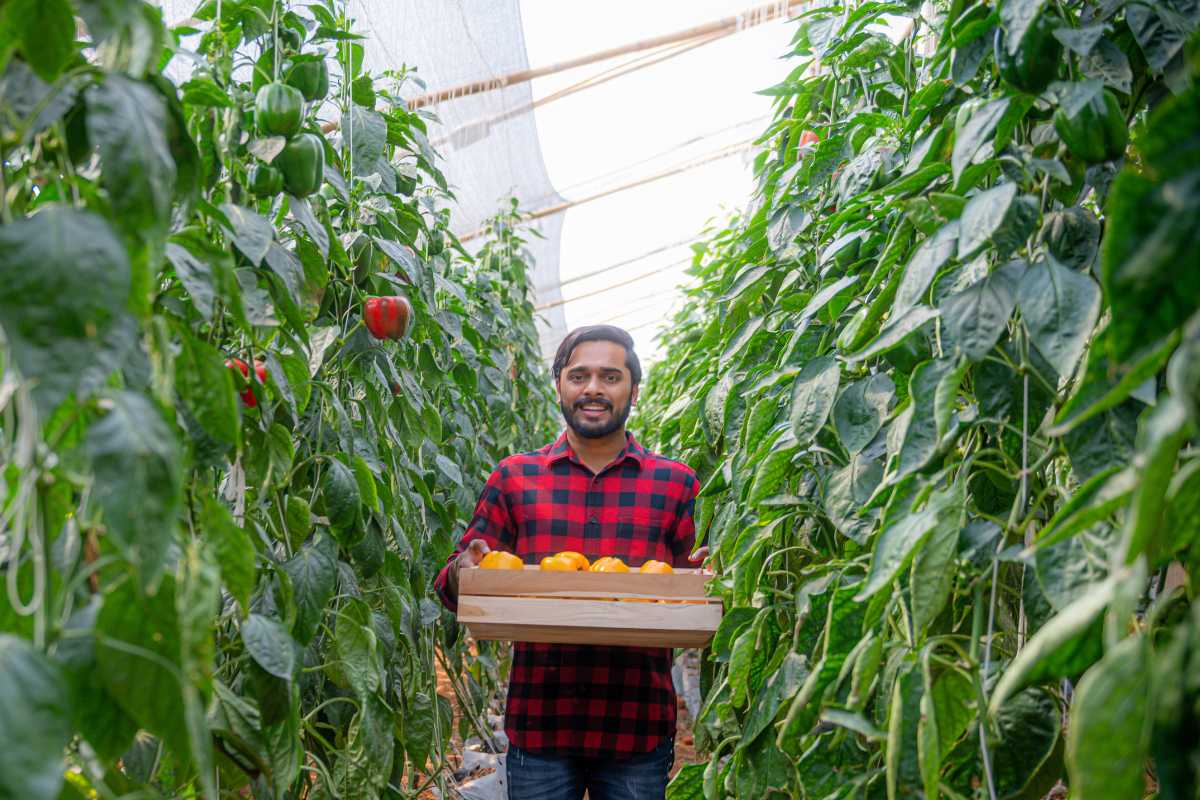
Hydroponically grown peppers can take between 50-80 days to grow until they can be successfully harvested. The process is determined by the specific type of peppers that are cultivated.
The ripening process for certain peppers can last up to 150 days before they are ready for harvest.
Troubleshooting Hydroponically Growing Peppers
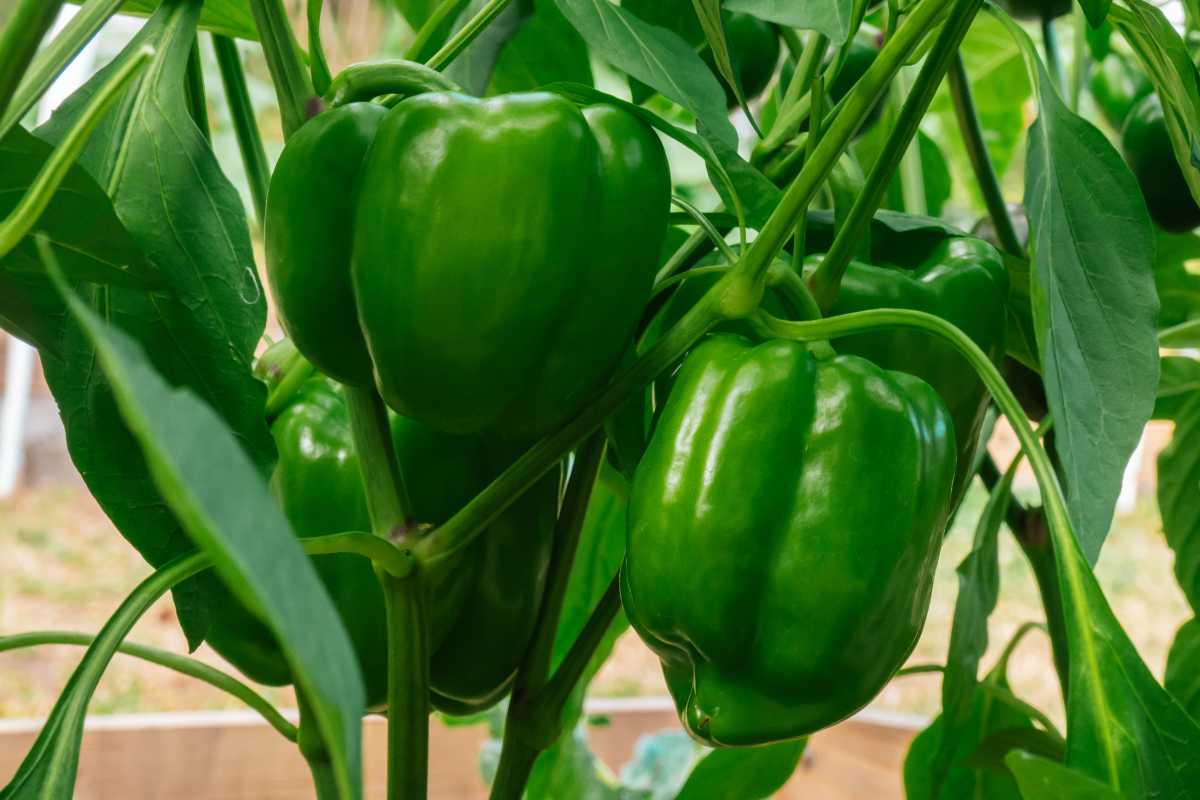
Common Growth Problems
Some of the most common growth problems that are prevalent with hydroponics are:
Poor Lighting
The absence of light, insufficient lighting, or incorrect lighting can create a serious problem with the growth of your plants.
Pepper plants naturally need sunlight for photosynthesis and store energy for their growth.
A solution is to use LED grow lights that provide the right spectrum of light for your plants to grow. Strong fluorescent growth lights can also be used instead of LEDs.
Insufficient Ventilation
Plants require a consistent supply of oxygen for both their roots and leaves in order to survive. Insufficient ventilation may result in a carbon dioxide buildup, leading to oxygen deprivation for plants.
Humidity
High humidity levels in a hydroponic room will unfortunately create the perfect environment for fungus to develop. To avoid fungus from growing on your pepper plants, keep the humidity levels down.
A dehumidifier will be able to regulate the humidity levels in your hydroponic environment. It’s certainly a piece of equipment you can’t afford to possess.
Incorrect Nutrients and pH Levels
The key to a successful hydroponic system is giving your plants the right hydroponic nutrient solution to assist them with their growth as your plants need sufficient nutrients to sustain themselves.
A common problem experienced with hydroponic peppers is using the wrong nutrient solution.
A solution for beginner hydroponic pepper growers that are experiencing poor growth is to use an EC meter and follow a feeding chart guide.
Along with the correct nutrient solution is the correct pH levels. Incorrect pH levels in your freshwater will lead to blossom-end rot in your peppers and wilted leaves.
Use a pH tester to check your water’s pH levels on a regular basis.
Common Pests
Although most hydroponic systems are in an indoor location, somehow, crop pests will still manage to find a way to ruin your entire crop.
The most common pests that will try to destroy your pepper plants are:
- Aphids – Aphids are small sap-sucking insects that can damage your pepper plants by sucking the plant’s juices and producing a sticky residue known as honeydew which encourages sooty mold growth. They also transmit plant diseases and can cause leaves to curl or yellow.
- Spider Mites – Spider mites are tiny, eight-legged arachnids that feed on the sap from the leaves of pepper plants. A pepper plant can be destroyed rapidly as they extract the essential nutrients and moisture from the leaves, leading them towards turning yellow and brittle.
- Fungus Gnats – A type of small, black flying insect that feeds on the roots and stems of pepper plants. The larvae’s consumption of the plant’s roots and stem results in negative effects such as wilting, yellowing leaves, and stunted growth.
- Whiteflies – A species of small, flying insects that extract plant sap as their food source. They are particularly drawn to pepper plants and can cause damage by sucking out the plant’s vital nutrients. Whiteflies also secrete a sticky substance called honeydew, which can attract ants and mold.
Solution
To prevent common pests from destroying your pepper plants, you can use pesticides, sticky traps, and neem oil. Regularly check your plants for any noticeable signs of pests.
Additionally, introducing ladybugs to your crop will prevent aphids from attacking your plants.
Common Diseases
Using water as a base to grow plants will avoid the most common diseases that are found in the soil.
Hydroponics provides a bigger challenge. Fungus and waterborne diseases can ruin your crops, should you not pay particular attention to your plants’ health.
Some of the most common diseases that will affect your hydroponic pepper plants are:
Root Rot
Root rot is a common disease that occurs in hydroponics. The disease causes the plant roots of your peppers to decay. Root rot causes slime to form on your roots.
The slime begins to suffocate your roots of oxygen, and they will turn a brown color.
Root rot can be prevented by supplying a constant flow of oxygen to the roots of your pepper plants. The water in your reservoir must be circulated and try to avoid it from becoming stagnant.
Keeping light away from your roots is also an important factor in preventing root rot. You can generally spot root rot in a plant if its leaves turn yellow and the plant is hanging and droopy.
You can cure your pepper plants from root rot, should you catch it fast enough. Proper maintenance of a hydroponic system involves removing the plants, cleaning the water containers, and sterilizing the container.
To maintain the health of your pepper plant, it is necessary to eliminate infected roots and replace the water in the reservoir. Soaking your plant’s roots in a water and hydrogen peroxide solution for 24 hours will kill root rot.
Powdery Mildew
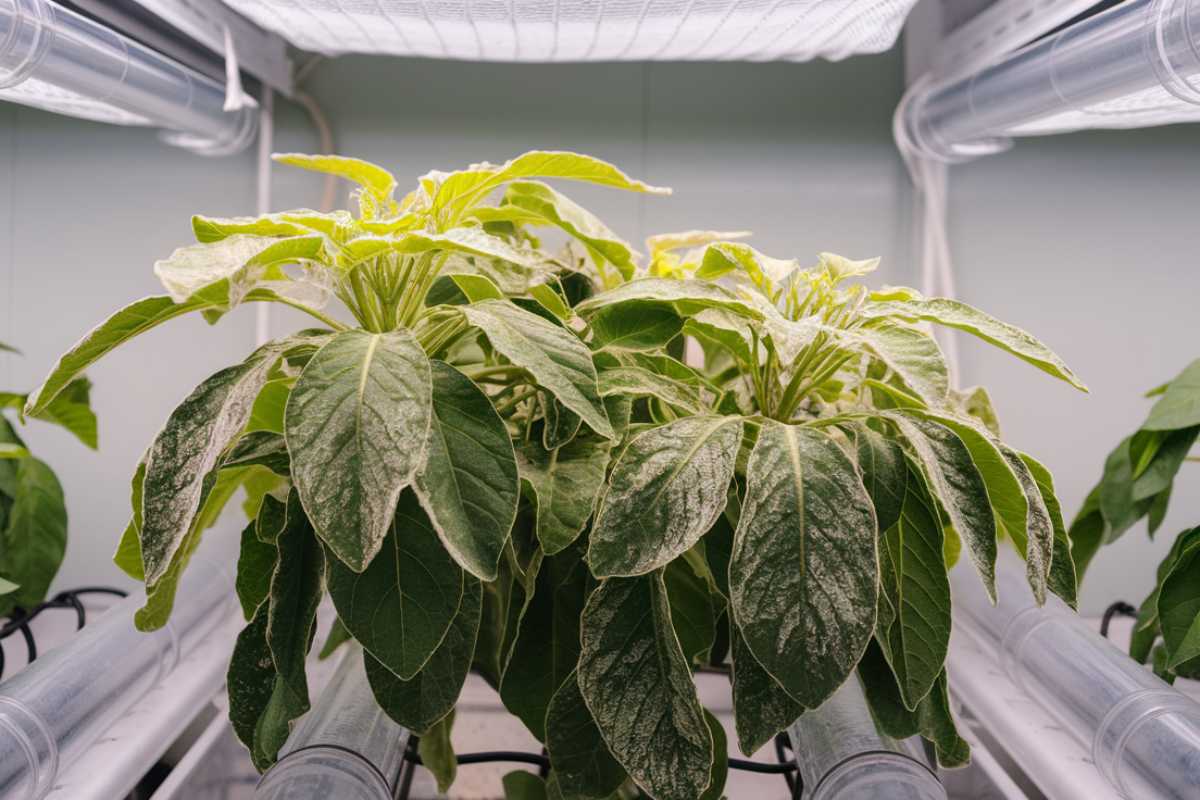
Powdery Mildew is a common fungus that affects the leaves of your pepper plant. The presence of a white powdery substance on plants indicates the onset of a disease.
The disease can be caused by factors like inadequate lighting, ventilation, and excessive humidity.
The disease will weaken your plant and can in severe cases kill your plants.
Proper ventilation and low humidity can help prevent the spread of disease in plants.
Applying a potassium bicarbonate solution to plants can effectively eliminate powdery mildew as well.
Gray Mold
Gray Mould is a disease that occurs in cooler climates with high levels of humidity. The disease can be identified as powdery spots on a plant.
If a plant becomes infected with this disease, it is advised to remove it from the hydroponics system due to the potential for rapid spread.
To reduce the likelihood of this illness, it is advised to eliminate deceased leaves from pepper crops and sustain minimal moisture levels in hydroponic systems.
Final Thoughts on Growing Hydroponic Peppers
Revolutionize your indoor growing space or hydroponic garden with the valuable addition of hydroponic peppers.
Unlock the full potential of your hydroponic peppers with the key to success—maintaining optimal conditions in your system.
Keep a watchful eye on your plant’s pH levels and ward off pesky pests and diseases that could hinder their growth.
Healthy and delicious peppers can be grown successfully in a hydroponic system with proper care and attention!
For those interested in gaining more knowledge about hydroponic peppers, we recommend reviewing these articles:

